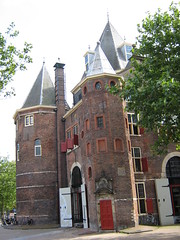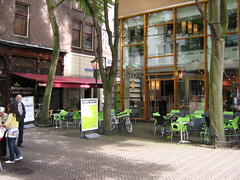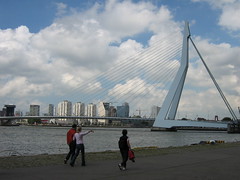After a busy few days, here I am again. The conference in Utrecht was mixed; I saw several interesting key note speakers, including Katherine Hayles and Joanna Zylinska, and I met some very nice, interesting people, including Renee Turner, an artist from Geuzen.org, Yasco Horsman, from the University of Leiden, and Manuela Rossini from the University of Amsterdam. I think though that at both this conference and at New Network Theory, many of the panels would have been better as roundtable discussions.
Let’s see, I’ll comment on the best of the talks tomorrow when I’m not so tired. I still feel pretty washed out because I spent most of yesterday (and last night) at the Piet Zwart Media Design graduation, final show, and opening/graduation party. That was all at Worm, a music/art/cultural space here in Delfshaven. I’m interviewing the director, Hajo Doorn tomorrow, about the Worm is organized. The graduation was really great. Worm is a great space for the students to install their projects, and the projects themselves were quite interesting. Kristina, one of the tutors, made a speech full of advice, and then Florian spoke, starting with the hope that they didn’t regret working with him, since he took over as Course Director half way through their program and had been a hard-ass. It was a startlingly candid statement for a graduation speech! The nicest thing though was how personal the whole event was. There were only nine students graduating so each was individually addressed–maybe it was too personal for some of the students who seemed really embarrassed when Florian made (positive) comments about each of their work and personalities. Then we had some lunch, and then Florian gave another general speech opening the show, and then we all hung around for a few more hours. I talked to several students about their projects; one of my favorites was by Andrea Fiore, called Cookie Census. This project is:
A software platform for the collaborative tracking and annotation of web cookies. Considering them identifiers and actuators of user control, the Cookie Census provides a distributed system for their survey and annotation. (Realized as a combination of a web browser plugin, MySQL database and web site.)
Finally around 7 or 8 I went to dinner with Florian, Josephine Bosma, and her daughter Jasmin. Because the good place we wanted to go was too crowded, we instead had some Roti, which was also good, but my duck had a ridiculous number of little broken bones in it. Anyway, Josephine is an interesting person; I’ve enjoyed reading her articles about digital media, and the art/theory scene in Europe and was happy to meet her in person. Jasmin is also really cool–I hope my girls are as much so when they reach her age.
So, we went back to Worm and the party opened at 9pm. I looked at more projects and had a chance to talk again at length with Mirko Schaefer whom I had seen and briefly met at the Network theory conference. he’s a really nice guy who does a lot of research about open source communities, and is finishing up his dissertation at Utrecht University where he’s a lecturer. Now I’m going to dinner, so I’ll write more later. –and damn, the blockquote has messed up my spacing.



